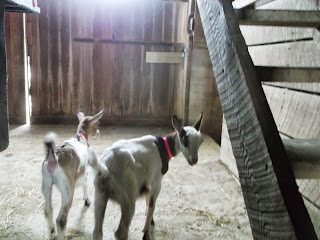Have you ever read the label on your store-bought lotion? Here are some of the ingredients on a bottle I have here at home:
 Water, Dimethicone, Ceteareth-20, Diasolidinyl Urea, Methylparaben, Tetrasodium EDTA, Propylene Glycol
Water, Dimethicone, Ceteareth-20, Diasolidinyl Urea, Methylparaben, Tetrasodium EDTA, Propylene Glycol
I don't know about you, but I only know what one of those ingredients is, so I did a little research.
Dimethicone is a form of silicone and has a variety of uses. It is one of the ingredients of silly putty, different types of caulking, and McDonald's chicken nuggets. It decreases foaming, is used in shampoos to help make hair shiny, and a form of it is used in the treatment of head lice.
Ceteareth-20 is another ingredient that helps to thicken lotions and stabilize emulsions. But it can also alter your skin structure and increases the speed and ability of other ingredients to penetrate your skin and enter the bloodstream. It is not recommended for damaged skin and is also restricted in skincare products.
Diazolidinyl Urea is an antimicrobial agent that slowly releases formaldehyde (Yikes!) in order to preserve lotions. It is found in almost all types of skincare products.
Methylparaben is a member of the paraben family and is another preservative. Parabens do occur naturally, in the body and in certain plants, like blueberries, which is why they are generally considered safe in small amounts. But because several types of parabens are often used in one product and parabens are used in virtually all skincare products, it is easy for our bodies to absorb way more than a normal amount. Parabens have been found in breast cancer tumors and have also been found to mimic estrogen and disrupt hormone function.
Tetrasodium EDTA is yet another preservative that breaks down the skin's protective barrier in order to enhance absorption.
Propylene Glycol helps lower the melting point of water, so it is used in de-icing agents and antifreezes. It is used in lotions and other skincare products as a humectant, which means it helps to attract and retain moisture to the skin. It is also sometimes used as a preservative in foods and as a solvent in pharmaceuticals.
Water is, well, we all know what water is. But, when water is added to a lotion, it automatically creates the need for a preservative, because water creates an environment perfect for bacteria growth. It also is very drying. If you've ever washed dishes several times a day in the winter and ended up with severely chapped hands, you realize just how drying it is. And often, water is the first ingredient listed, meaning it is the most plentiful ingredient, meaning your lotion bottle you paid big bucks (or small bucks) for is really, mostly, just water.
While many lotions also include healthy, natural ingredients like Aloe Vera, Grape Seed Extract, and Glycerine, they also contain preservatives and other artificial ingredients in order to prolong shelf life, stabilize ingredients, and encourage your skin to absorb more of their product.
I'm kind of grossed out to find out what truly is in my lotion. Are you? Well, there's good news. Lonely Windmill Farm now sells handmade lotion! We wanted to create a product that would not only moisturize your skin, but would also be void of all that other yucky stuff that isn't good for your skin. We wanted a moisturizer that contained healthy oils, but that wasn't too greasy or messy. We didn't want to add water, but we wanted it to be easy to use. And so we created our body lotion sticks.

Our body lotion sticks contain only good stuff: Beeswax, Olive Oil, Shea Butter, Mango Butter, Coconut Oil, and Vitamin E. Olive Oil and Coconut Oil help moisturize, nourish, and regenerate your skin because they naturally contain vitamins and minerals your skin needs to thrive. Mango Butter is helpful in reducing wrinkles, while Shea Butter is a natural sunscreen that also helps soothe irritated skin. Beeswax prevents your skin from losing moisture and protects it from the drying effect caused by wind, sun, and water. We use minimally processed and unrefined products in our lotion sticks to ensure that you get the most skin-nourishing vitamins as possible. While we love the goat milk in our soap, we didn't add it to our lotion because that would force us to add some of the yucky preservatives I listed. When we add milk to our soap, it undergoes a chemical reaction which changes the goat milk and preserves it. But there's no chemical reaction in our lotion sticks, so we left it out because we felt the negatives of the preservatives outweighed the positives of the goat milk.

Since we don't add water to our lotions, they are hard, like a large lip balm. We pour them into a twist-up tube, so all you have to do is rub it on your skin. One thing I have always hated about lotions is how greasy my hands get when I applied it. With our lotion sticks, I never have to touch the lotion (unless my hands need some TLC!)--I apply it, and then I don't have to wash my hands before doing something else. Also, you can put it in your purse or a bag without worry about whether it will leak all over everything. They come in four varieties: Simply Sweet, Oatmeal, Milk and Honey, Black Raspberry, and Natural (unscented). We now have them available on our
website. If you love our soap, we have a feeling you'll love our lotion.
For more info on common skincare ingredients, check out these two sites:



















